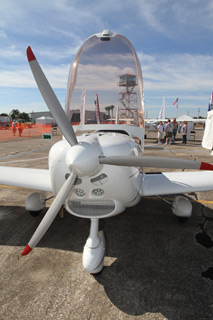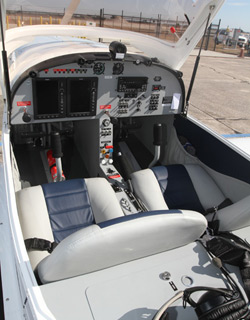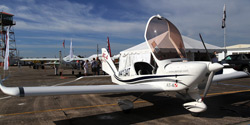
The Aero AT-4 was previously sold in the United States under the Gobosh brand, but a new distribution deal has been struck to market the airplane under its factory name.

A carbon composite, ground-adjustable propeller, LED landing lights, and a castering nosewheel are standard equipment on the Aero AT-4, an all-metal design built for flight training and grass strips.

This photo, taken at eye level by a six-foot-tall pilot in the left seat of the Aero AT-4 illustrates the limited forward visibility on the ground.

The Aero AT-4 panel includes a cluster of caution lights, at top left, that quickly alert the pilot to engine warnings and cautions, fuel pump status, low fuel state, and an unlocked canopy.
AT-4 Specifications
- Engine: Rotax 912ULS, 100 hp
- Propeller: ELPROP ground-adjustable, carbon composite, three blades
- Basic empty weight: 838 lbs
- Useful load: 481 lbs
- Fuel capacity: 18.5 gallons (center mounted tank)
- Wing span: 27.4 ft
- Cruise speed: 105 KIAS
- Max cruise: 116 KIAS
- Vne: 133 KIAS
- Va: 90 KIAS
- Rate of climb: 965 fpm
- Ceiling: 14,435 MSL
- Range: 387 nm
- Price (typically equipped): $132,000
Of the dozens of aircraft that converged on the Sebring U.S. Sport Aviation Expo Jan. 19 through 22, the Aero AT-4 had the most challenging journey. The Polish-made light sport aircraft was nearly grounded by U.S. Customs inspections, caught in a Catch-22: Inspectors sought an airworthiness certificate that could not be obtained until the aircraft cleared customs. With help from the FAA, Greg Trzaska, the newly signed U.S. distributor for Aero AT and a flight school operator in Northampton, Mass., managed to get the red tape cut in the nick of time, arriving in Florida with no time to spare.
The aircraft itself, with side-by-side seating for two, metal skin, and a rugged design made for European grass strips and flight training, is new to the U.S. market only in name. Sold previously under the brand name Gobosh (Go Big or Stay Home), this LSA ranked eighteenth in light sport market share by September 2011, with 23 aircraft, according to data compiled on ByDanJohnson.com . After a turbulent year of transition, Aero AT CEO Walter E. Jankowski struck a new distribution deal with Trzaska, who will also support the existing fleet of about 28 Gobosh aircraft.
 The Aero AT-4 comes equipped with dual Garmin GTX displays, a GTX 330 transponder, and SL40 radio for $132,000, delivered to Northampton, Mass.
The Aero AT-4 comes equipped with dual Garmin GTX displays, a GTX 330 transponder, and SL40 radio for $132,000, delivered to Northampton, Mass.
Aside from a new paint scheme, the AT-4 that made the trip south from Northampton for the expo was virtually identical to the Gobosh 700s already flying around the country. Built in the same factory, the design lineage traces back about 15 years, an adaptation of the certified Aero AT-3, the AT-4 was tailored to the U.S. light sport market.
Climbing aboard for a brief demonstration ride on Jan. 22 (the crew was preparing for the long return flight to Northampton), there is ample shoulder room for a six-foot-tall, 200-pound pilot next to a slightly smaller CFI, Mike Kuehlmuss, who teaches at Northampton Airport and uses Trzaska’s Gobosh (purchased long before he became a distributor) for many introductory flights. The seats are comfortable; forward visibility is, however, surprisingly limited through the forward-tilting bubble canopy. The AT-4 sits low on its main gear, the nose angling upward over a castering nose wheel, though not as much as a taildragger.
Gobosh exits the picture, Aero AT-4 flies on
Greg Trzaska was on his way to take a demo flight in a Cessna Skycatcher when a call from Poland abruptly changed his course.
Aero AT, the aircraft maker that established a U.S. light sport presence with the Gobosh 700, was in search of a new distributor. Investors who announced in 2010 a new deal to keep the Gobosh brand alive had exited the picture. Trzaska, who purchased a Gobosh in 2009 with 1,000 hours already logged by a flight school, decided to step up to the challenge and take over the brand.
Reintroduced for the Sebring U.S. Light Sport Expo as the Aero AT-4, the aircraft is unchanged from design previously marketed in the United States under the Gobosh name.
Chris Dillis, one of the investors who worked in 2011 to put together a new Gobosh distributorship, explained in an email that uncertain economic times and the major commitment of time and money required prompted the decision to abort a Gobosh rebirth.
“Knowing that the airplane would continue to be represented in the US without us, we decided to bow out,” Dillis said, adding he still believes strongly in the model.
Aero AT CEO Walter E. Jankowski, who made the trip to Sebring, Fla., for the expo, said the company will work closely with Trzaska to spread the word that the AT-4 is still the same Gobosh that ranked eighteenth in LSA market share by September 2011.
“We do have to build kind of a name recognition,” Jankowski said.
With the preflight completed in advance of the reporter’s arrival (Kuehlmuss contented himself with a final check of the fuel in the tank mounted directly behind the Rotax 912), the engine starts easily. An oil heater helps shorten the delay, common to Rotax engines, required to achieve operating temperature. Winds are light and variable, skies clear, and taxi clearance is given quickly.
Kuehlmuss explains the technique for holding the centerline: Maintain gentle pressure on both rudder pedals, and nudge the left and right toe brakes to guide the nose during taxi. It’s easy to get the hang of, even for an LSA rookie, and the nose holds the centerline well. A short runup gets the oil temperature—displayed on one of two Garmin G3X displays on the left side of the panel—into the yellow range, and N413AT is cleared for takeoff and a southwest departure. The AT-4, under Kuehlmuss’ control, breaks free of the pavement in roughly 350 feet, and climbs steadily at close to the 965 fpm published in the factory specifications, at 60 KIAS.
This AT-4 is outfitted with dual throttles, each protruding from the panel. Unlike the center throttle, the left-hand throttle has no friction lock, and Kuehlmuss said it will likely be eliminated from future deliveries. It is well within range of the left-seat pilot/passenger’s knee, inviting inadvertent power application.
After climbout, Kuehlmuss hands over the controls and a sedate, stable aircraft reveals itself. Aileron control is crisp, with a light touch and smooth response to a few Dutch rolls. Slowing down, the AT-4 is reluctant to stall, airspeed bleeding slowly with flaps up and the 100-hp Rotax idling. A gentle buffet finally begins around 45 KIAS, with a full stall developing around 42 KIAS that is downright docile.
“No surprises,” Kuehlmuss said. “That’s what we like.”
Roll control is mushy as the minimum controllable airspeed approaches, but shallow turns are easy enough to accomplish. Flaps, extended with a manual lever in the center console familiar to Piper pilots, decrease the stall speed to 39 KIAS, according to factory specifications, though the AT-4 can sustain lift at lower speeds. Kuehlmuss said he was able to maintain 33 KIAS during test flights.
 Polish aircraft maker Aero AT is hoping to build on a U.S. market foothold established under the Gobosh name, which ranked eighteenth in U.S. LSA sales by September 2011.
Polish aircraft maker Aero AT is hoping to build on a U.S. market foothold established under the Gobosh name, which ranked eighteenth in U.S. LSA sales by September 2011.
On final approach, Kuehlmuss (back at the controls, with the reporter and LSA rookie deferring to the CFI), works the ailerons rapidly despite seemingly little turbulence or crosswind, occasionally bumping the left-seat passenger’s knee with the joystick. The AT-4 tracks the centerline well enough on touchdown, and settles into a relatively gentle landing.
The AT-4 will be marketed to flight schools as well as individual buyers in search of a steady performer at a price point lower than many LSA models. An AT-4 equipped with dual Garmin GTX displays; an SL40 radio; GTX 330 transponder; three-blade, ground-adjustable carbon composite ELPROP propeller; and lights for night operation costs $132,000 delivered to Northampton, Mass. An analog airspeed indicator and altimeter was also present in the panel of N413AT, and Trzaska said an analog six-pack is an available option.
Kuehlmuss said the forgiving AT-4 is a good match for flight training, and students can reasonably expect to complete their sport pilot certificate close to the minimum 20 hours.



